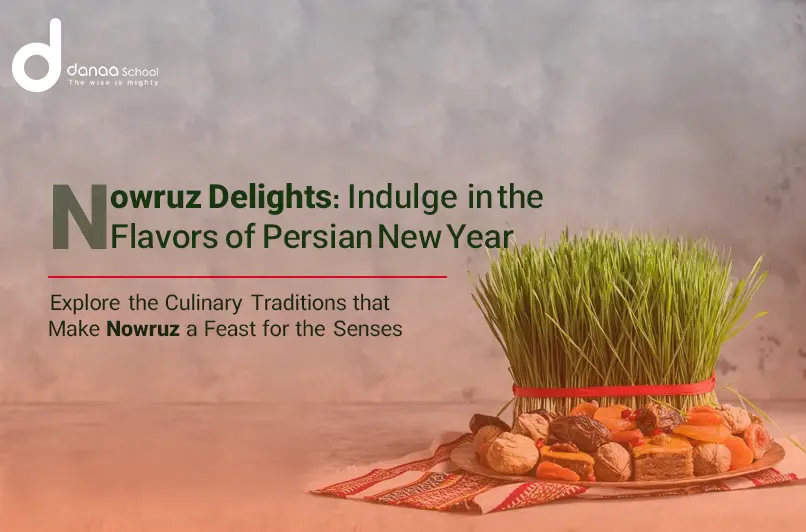Nowruz, the Persian New Year, is a joyous celebration that marks the arrival of spring and the beginning of a new year in the Persian calendar. It is a time of renewal, reflection, and familial bonds. Central to the festivities are the delicious culinary traditions passed down through generations. In this article, we’ll explore the delightful world of Nowruz food and the rich cultural significance behind it.
What Do They Eat on Nowruz?
During Nowruz, families come together to share a feast that includes a variety of traditional dishes. These dishes often symbolize themes such as rebirth, prosperity, and happiness. Some staple foods enjoyed during Nowruz include Sabzi Polo ba Mahi, a fragrant rice dish with herbs and fish symbolizing growth and abundance.
Ash-e Reshteh, a hearty noodle soup made with beans, herbs, and noodles, representing good fortune and prosperity, and Kuku Sabzi, an herb-packed omelette symbolizing the arrival of spring and new beginnings. These dishes are not only delicious but also deeply rooted in the cultural heritage of Iran, showcasing the diversity and richness of Persian cuisine.
Food Symbolizing Nowruz
Each dish served during Nowruz carries its symbolic meaning. For example, the seven ingredients used in Haft-Seen, a traditional Nowruz spread, represent the seven angelic heralds of life. Additionally, certain foods like wheat sprouts (sabzeh) symbolize rebirth, while dried fruits and nuts represent the sweetness of life.
These symbolic foods are often arranged on a ceremonial table known as the Haft-Seen, which serves as a focal point for Nowruz celebrations and is adorned with items representing different aspects of life and nature.
What Do You Bring to a Nowruz Party?
When attending a Nowruz gathering, it’s customary to bring a gift or dish to share with the host and other guests. Popular contributions include sweets such as baklava or Persian pastries and traditional Nowruz treats like colored eggs and fresh fruits. This tradition of bringing gifts fosters a sense of generosity and community among participants, reinforcing the spirit of sharing and abundance that defines Nowruz.
Nowruz Food Traditions
Nowruz food traditions have deep roots in Persian culture and history. Many of these culinary customs date back thousands of years and have been preserved through oral tradition and family recipes. These traditions vary from region to region but are united in celebrating spring and renewal. Families often gather to prepare these dishes, passing down recipes and techniques from generation to generation. This sense of continuity and connection to the past is integral to Nowruz celebrations, reinforcing the importance of family and heritage.
Nowruz Traditional Food
Traditional Nowruz dishes reflect the diverse culinary landscape of Iran. From rich stews and aromatic rice dishes to delicate pastries and refreshing salads, there is something for everyone to enjoy during the festivities. Some classic dishes include khoresh-e bademjan (eggplant stew), zereshk polo (barberry rice), and fesenjan (pomegranate walnut stew).
These dishes are often prepared with care and attention to detail, using fresh, seasonal ingredients to enhance their flavor and aroma. They are a testament to the ingenuity and creativity of Persian cooks, who have perfected the art of combining simple ingredients to create complex and flavorful dishes.
Nowruz Food Menu
Planning a Nowruz feast? Consider including dishes like Dolmeh Barg (stuffed grape leaves), Mast-o-Khiar (cucumber yogurt dip), and Joojeh Kabab (grilled chicken skewers) on your menu. These dishes showcase the vibrant flavors and culinary traditions of Persian cuisine.
In addition to these savory delights, don’t forget to include a variety of side dishes, condiments, and desserts to create a well-rounded and satisfying meal for your guests. Whether you’re hosting a large gathering or an intimate family dinner, there’s no shortage of delicious options when planning your Nowruz menu.
Nowruz Food Recipes
Want to recreate the flavors of Nowruz at home? Here are some easy-to-follow recipes for classic Nowruz dishes:
– Recipe: Sabzi Polo ba Mahi
– Ingredients: rice, herbs, fish, saffron, oil
– Instructions: Cook rice with herbs and saffron, fry fish until golden brown, serve together for a flavorful and aromatic dish.
– Recipe: Ash-e Reshteh
– Ingredients: lentils, beans, noodles, herbs, garlic, onion
– Instructions: Cook lentils and beans with herbs and garlic, add noodles, and cook until tender; serve hot with a dollop of yogurt for a comforting and nourishing soup.
– Recipe: Kuku Sabzi
– Ingredients: eggs, herbs, onion, garlic, baking powder
– Instructions: Beat eggs, mix with chopped herbs, onion, and garlic, add baking powder for fluffiness, cook until set and golden brown, serve as a flavorful and nutritious omelette. These recipes are perfect for novice cooks and experienced chefs alike, allowing you to experience the flavors of Nowruz in the comfort of your own home.
Nowruz Desserts
No Nowruz celebration is complete without something sweet to end the meal. Indulge in Persian delights like shirini keshmeshi (raisin cookies), baklava (filo pastry filled with nuts and honey), and saffron ice cream for a decadent finish to your feast.
These desserts are often enjoyed with a cup of tea or coffee, providing a delightful end to a festive meal. They are also perfect for sharing with friends and family, allowing you to spread joy and sweetness during this special time of year.
Nowruz Snacks
Keep guests satisfied between meals with a selection of savory snacks and appetizers. Serve up crispy falafel, tangy olives, and crunchy nuts for a satisfying nibble that pairs perfectly with a refreshing drink.
These snacks are easy to prepare and can be enjoyed by guests of all ages, making them the perfect addition to any Nowruz gathering. They are also versatile and can be customized to suit your taste preferences, allowing you to create a unique and memorable dining experience for your guests.
Nowruz Traditions
In addition to feasting delicious food, Nowruz is a time to observe cherished traditions and customs. From jumping over bonfires to decorating eggs, each ritual is steeped in symbolism and meaning, connecting individuals to their cultural heritage and community.
These traditions create a sense of continuity and belonging, bringing people together to celebrate the beauty of spring and the promise of a new year. Whether participating in age-old customs or starting new traditions, Nowruz is a time to honor the past while embracing the future and creating memories that will last a lifetime.
Persian Food
Persian cuisine is renowned for its bold flavors, aromatic spices, and inventive use of fresh ingredients. Staples like saffron, rose water, and pomegranate molasses are often used to enhance the taste and aroma of dishes, resulting in a culinary experience unlike any other.
Persian food is not only delicious but also reflects the region’s rich history and diverse cultural influences, making it a favorite among food enthusiasts worldwide. Whether you’re enjoying a simple meal at home or dining out at a Persian restaurant, you’re sure to be captivated by the flavors and textures of this vibrant cuisine.
Persian New Year 2024
As we usher in the Persian New Year in 2024, let’s celebrate with enthusiasm and gratitude for the past year’s blessings and the promise of the year ahead. Whether you’re honoring age-old traditions or adding a modern twist to your celebrations, may Nowruz bring joy, prosperity, and abundance to you and your loved ones.
This year, consider incorporating new flavors and dishes into your Nowruz feast, expanding your culinary horizons while honoring the rich traditions of this ancient holiday. From classic dishes to contemporary creations, there’s no limit to the culinary delights that await as we welcome the arrival of spring and the beginning of a new year.
Conclusion
Nowruz is a time of joy, renewal, and connection. By embracing the rich culinary traditions of this ancient holiday, we can celebrate the arrival of spring and the promise of new beginnings with delicious food and cherished rituals.
From traditional dishes to modern interpretations, Nowruz offers a feast for the senses and the soul, bringing people together to celebrate life, love, and community. As we gather with friends and family to mark this special occasion, let’s savor every moment and create memories that will last a lifetime.
Join Danaa School today and start a journey to deepen your understanding of Iranian culture, literature, and diverse celebrations! Immerse yourself in the rich tapestry of traditions, stories, and festivities that make Iran unique.
FAQs
1. What is the significance of Nowruz food?
– Nowruz food symbolizes themes such as rebirth, prosperity, and happiness, reflecting the holiday spirit. Each dish carries its symbolic meaning, connecting individuals to their cultural heritage and community and fostering a sense of unity and abundance.
2. What are some popular Nowruz desserts?
– Popular Nowruz desserts include shirini keshmeshi (raisin cookies), baklava, and saffron ice cream. These sweet treats are enjoyed by people of all ages, providing a delightful end to a festive meal and symbolizing sweetness and joy for the year ahead.
3. How do you pronounce Nowruz?
– Nowruz is pronounced “no-rooz” and translates to “new day” in Persian. It is celebrated as the beginning of spring and a new year in the Persian calendar, marking a time of renewal and optimism for the future.
4. What are some traditional Nowruz snacks?
– Traditional Nowruz snacks include crispy falafel, tangy olives, and crunchy nuts. These savory treats are perfect for sharing with friends and family, adding to the festive atmosphere of Nowruz gatherings and symbolizing abundance and hospitality.
5. How long does Nowruz last?
– Nowruz celebrations typically last for 13 days, culminating in the holiday of Sizdah Bedar, or Nature Day. During this time, people come together to enjoy delicious food, participate in cultural rituals, and celebrate the beauty of spring, marking the beginning of a new year with joy and optimism.
6. What Are Some Nowruz Traditions?
– Nowruz traditions include house cleaning, family gatherings, visiting loved ones, and preparing special foods.
7. Are There Specific Nowruz Activities for Children?
– Yes, there are various activities tailored for children during Nowruz, including egg decorating, storytelling about the festival’s traditions, and participating in community events like parades and picnics.







